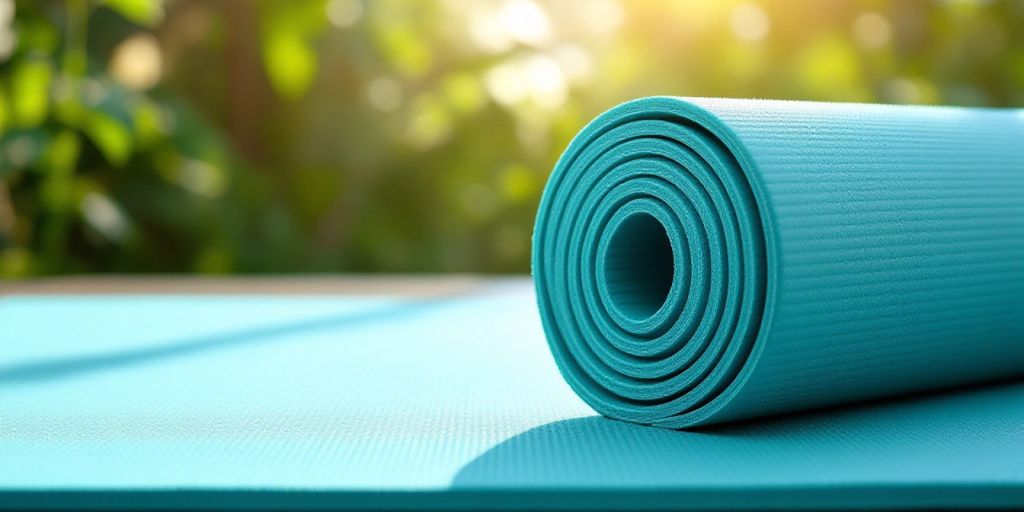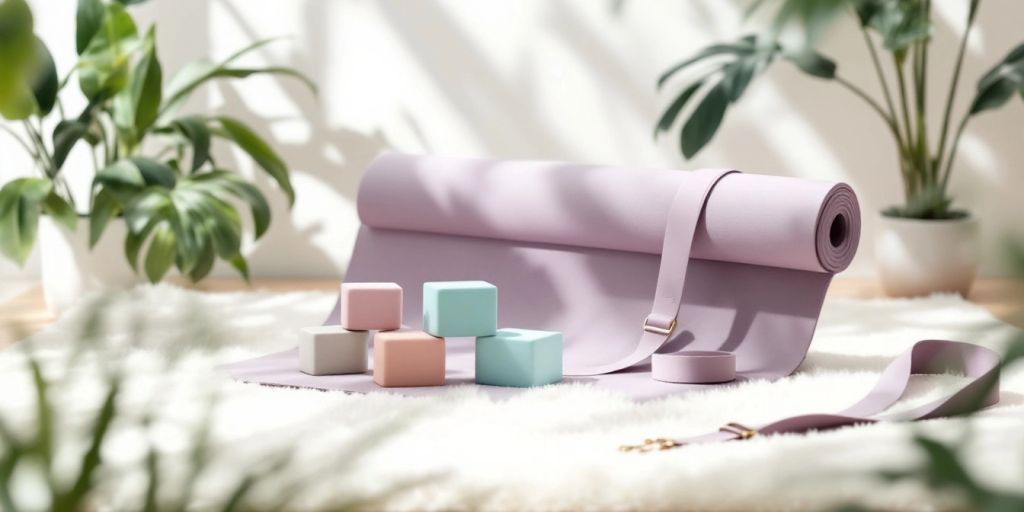
Discover the Benefits of an Easy to Clean Yoga Mat for Your Practice
Keeping your yoga mat clean is very important for both your health and your yoga practice. An easy to clean yoga mat not only helps you stay safe from germs and bacteria but also makes your sessions more enjoyable. In this article, we will explore the many benefits of using a mat that is easy to clean, how to maintain it, and tips for choosing the right one for you.
Key Takeaways
- Regular cleaning of your yoga mat helps prevent germs and bad smells.
- Using gentle cleaners keeps your mat in good shape.
- Proper storage is important to protect your mat and keep it clean.
- DIY cleaning solutions can provide a natural way to keep your mat fresh.
- Keeping your mat clean helps maintain its grip and makes your practice safer.
Understanding the Importance of an Easy to Clean Yoga Mat

Keeping your yoga mat clean is vital for your health and enhances your practice. A tidy mat helps prevent the spread of germs and makes your sessions more enjoyable. Here are some key reasons why maintaining a clean yoga mat is important:
Health Benefits of a Clean Mat
- Reduces the risk of infections and skin irritations.
- Helps eliminate odors caused by sweat and bacteria.
- Promotes a healthier environment for your practice.
Impact on Yoga Practice
- A clean mat provides better grip, enhancing your performance.
- It allows you to focus on your poses without distractions.
- A fresh mat can boost your motivation to practice regularly.
Longevity of Your Yoga Mat
- Regular cleaning can extend the life of your mat.
- It prevents the buildup of dirt and oils that can degrade the material.
- Proper care ensures your mat remains in good condition for years to come.
| Aspect | Benefits |
|---|---|
| Health | Reduces infections, promotes hygiene |
| Practice | Enhances grip, reduces distractions |
| Longevity | Extends mat life, maintains quality |
Keeping your yoga mat clean is not just about hygiene; it’s about enhancing your overall yoga experience. A clean mat can make all the difference in your practice!
How to Maintain an Easy to Clean Yoga Mat

Quick Wipes After Each Session
After each yoga session, it's essential to give your mat a quick wipe down. This helps remove sweat and dirt that can build up. Here’s a simple routine to follow:
- Lightly spray your mat with a gentle cleaner.
- Wipe it down with a soft cloth.
- Hang it to air dry before rolling it up.
Using Gentle Cleansers
When cleaning your mat, always choose mild, natural cleansers. Harsh chemicals can damage the material. A simple mixture of vinegar and water works well. Here’s a quick recipe:
| Ingredient | Amount |
|---|---|
| Water | 1 part |
| White vinegar | 1 part |
| Essential oil (optional) | A few drops |
Proper Drying Techniques
After cleaning, allow your mat to dry completely. This prevents mildew and keeps it fresh. Here are some tips for drying:
- Hang your mat in a well-ventilated area.
- Avoid direct sunlight, as it can damage the material.
- Ensure it’s completely dry before rolling it up to store.
Regular maintenance is key to keeping your yoga mat in great shape. A clean mat not only enhances your practice but also extends its life. Remember to treat your mat with care, especially if you have a dy66 trekk travel mat that is lightweight and eco-friendly, ensuring a safe practice.
Choosing the Right Easy to Clean Yoga Mat
When selecting a yoga mat, it’s essential to consider how easy it is to clean. A mat that is simple to maintain can enhance your practice and keep you healthy. Here are some key points to think about:
Materials That Are Easy to Clean
- Natural Rubber: This material is not only eco-friendly but also easy to wipe down.
- PVC: Known for its durability, PVC mats can be cleaned with mild soap and water.
- TPE: This is a newer material that is lightweight and easy to maintain.
Eco-Friendly Options
Choosing an eco-friendly mat can be beneficial for both you and the planet. Look for mats made from:
- Natural rubber: Biodegradable and safe for the environment.
- Cork: Naturally antimicrobial and easy to clean.
- Recycled materials: These mats help reduce waste and are often easy to maintain.
Personalized Yoga Mats
Investing in a personalized yoga mat can make your practice more enjoyable. Here’s why:
- Customizable materials: You can choose materials that are easy to clean.
- Unique designs: A mat that reflects your style can motivate you to keep it clean.
- Durability: High-quality mats last longer, even with regular cleaning.
A clean mat is essential for a healthy practice. Choosing the right mat not only enhances your yoga experience but also ensures that you maintain a hygienic environment for your workouts.
In summary, when selecting an easy to clean yoga mat, consider the materials, eco-friendliness, and personalization options. This will help you find a mat that suits your needs and enhances your practice.
Benefits of Regularly Cleaning Your Yoga Mat
Keeping your yoga mat clean is essential for both your health and your practice. Here are some key benefits of regularly cleaning your mat:
Prevents Bacteria and Germ Build-Up
- Regular cleaning helps eliminate germs that can thrive on your mat, especially after a sweaty session. This is crucial for avoiding skin infections and other health issues.
- A clean mat reduces the risk of bacteria, fungi, and viruses, making your practice safer.
Maintains Grip and Traction
- Dirt and sweat can make your mat slippery, affecting your balance during poses. Regular cleaning keeps your mat’s grip intact, allowing for a safer practice.
- A well-maintained mat enhances your performance by providing the necessary traction.
Eliminates Odors
- Over time, mats can develop unpleasant smells due to sweat and bacteria. Cleaning your mat regularly helps keep it smelling fresh and pleasant.
- A clean mat not only feels good but also boosts your confidence in class.
Keeping your yoga mat clean is not just about hygiene; it’s about enhancing your overall yoga experience. A clean mat can make all the difference in your practice!
By regularly cleaning your mat, you ensure a healthier environment for your practice and extend the life of your mat, making it a worthwhile investment for your yoga journey. Remember, a clean mat is a happy mat!
DIY Cleaning Solutions for Your Yoga Mat
Keeping your yoga mat clean can be simple and cost-effective with homemade cleaning solutions. These natural options are gentle on your mat and your skin, avoiding harsh chemicals. Here are some effective recipes you can try:
Natural Cleaners and Their Benefits
- Vinegar and Water Solution: Mix equal parts of white vinegar and water in a spray bottle. This solution helps to kill bacteria and remove odors. Just spray it on your mat and wipe it down with a clean cloth.
- Essential Oils for Freshness: Adding a few drops of essential oils can enhance your cleaning solution. Popular options include:
- Tea Tree Oil: Known for its antibacterial properties.
- Lavender Oil: Provides a calming scent.
- Peppermint Oil: Offers a refreshing aroma.
Homemade Cleaning Recipes
To create your own mat spray, follow these steps:
- In a spray bottle, mix a solution of vinegar, baking soda, and a few drops of tea tree oil.
- Fill the bottle the rest of the way with water.
- Shake well before each use and spray lightly on your mat.
- Wipe down with a soft cloth.
Regular use of your DIY cleaner will help maintain the cleanliness and longevity of your yoga mat. Always patch test your homemade solution on a small area of the mat to ensure it does not cause any damage or discoloration.
By following these techniques, you can ensure that your yoga mat remains in top condition, ready for your next practice!
Tips for Extending the Life of Your Yoga Mat
Keeping your yoga mat in good condition is essential for a great practice. Here are some helpful tips to ensure your mat lasts longer:
Routine Maintenance Practices
- Wipe your mat after each use: A quick wipe down helps remove sweat and dirt, preventing buildup.
- Store it properly: Always roll your mat loosely and keep it in a cool, dry place away from sunlight.
- Use a mat towel: Placing a towel on your mat during practice can absorb sweat and protect the surface.
Avoiding Harsh Cleaners
- Stick to mild soaps or natural cleaners. Harsh chemicals can damage the material and reduce its lifespan.
- Consider using a simple mixture of vinegar and water for cleaning.
- Always patch test any new cleaner on a small area of the mat first.
Proper Storage Techniques
- Air it out regularly: Let your mat breathe by hanging it up after use to prevent moisture buildup.
- Avoid hot environments: Never leave your mat in a hot car or direct sunlight, as heat can degrade the material.
- If using a mat bag, ensure the mat is completely dry to prevent bacteria growth.
Regular cleaning can significantly extend the lifespan of your yoga mat. Taking care of your mat not only keeps it clean but also enhances your practice experience. Remember to treat your mat with care, especially if you have a personalized yoga mat that you love.
Common Mistakes to Avoid When Cleaning Your Yoga Mat
Using Harsh Chemicals
Using strong cleaning products can damage your mat. Stick to gentle, natural cleaners to keep your mat in good shape. Harsh chemicals can break down the material and affect its durability.
Skipping Regular Cleanings
It’s easy to forget to clean your mat, especially after a tough session. However, not cleaning regularly can lead to bacteria and odors building up. Make it a habit to wipe down your mat after each use to maintain its cleanliness.
Improper Drying Methods
After cleaning, it’s crucial to dry your mat properly. Avoid rolling it up while it’s still wet, as this can cause mildew. Instead, hang it up to air dry completely. Proper drying techniques help keep your mat fresh and extend its life.
Taking care of your yoga mat is essential for both hygiene and performance. Avoiding these common mistakes will help you maintain a clean and effective practice space.
Summary of Common Mistakes
| Mistake | Consequence |
|---|---|
| Using harsh chemicals | Damages mat material |
| Skipping cleanings | Bacteria and odor buildup |
| Improper drying | Causes mildew and odors |
Conclusion
Keeping your yoga mat clean is super important for both your health and your practice. In this article, we explored different ways to clean your mat, from quick wipes after each session to more thorough cleaning methods. Always remember to choose the right cleaning products based on what your mat is made of, and let it dry completely to prevent any bad smells or mold. By following these simple tips, you can make your yoga mat a fresh and inviting space for your practice. A clean mat isn't just about looking good; it helps you feel better and enjoy your yoga sessions even more.
Frequently Asked Questions
Why is it important to clean my yoga mat regularly?
Cleaning your yoga mat often helps get rid of germs and dirt, making it safer and more pleasant to use.
What are the best materials for easy-to-clean yoga mats?
Look for mats made from natural rubber, TPE, or PVC, as these materials are usually easy to clean.
How can I clean my yoga mat after each use?
You can quickly wipe it down with a damp cloth and a mild soap solution or a special yoga mat cleaner.
How often should I do a deep clean of my yoga mat?
It's a good idea to deep clean your mat every few months, or more frequently if you use it a lot.
Can I use vinegar to clean my yoga mat?
Yes, a mix of water and vinegar works well to clean and disinfect your yoga mat.
What should I avoid when cleaning my yoga mat?
Avoid using harsh chemicals or scrubbing too hard, as this can damage the mat.


